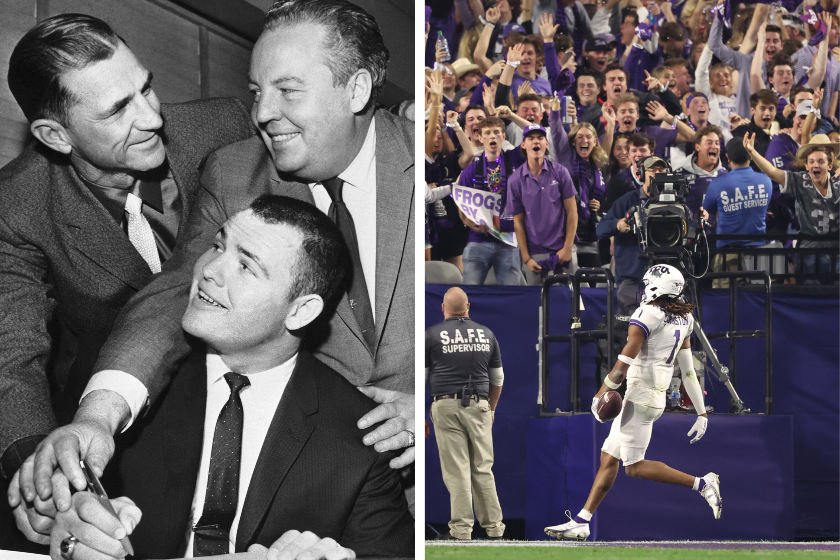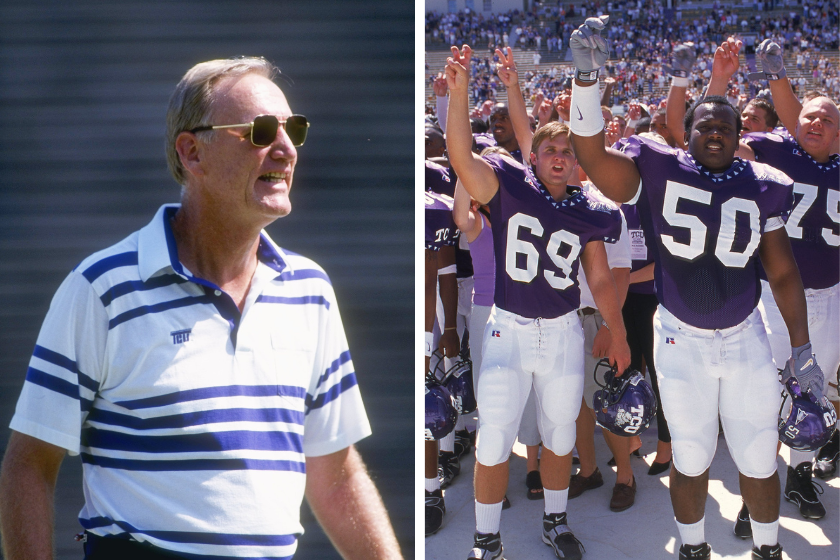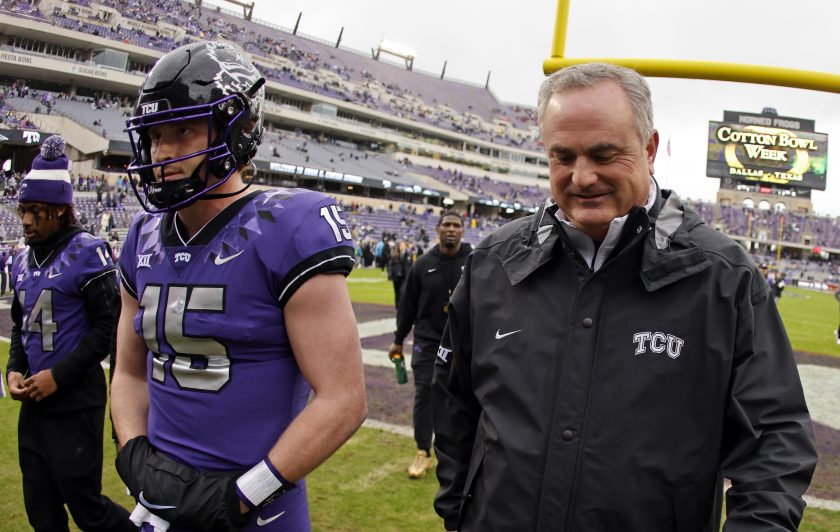The magical run that Texas Christian University has had this year has been a great surprise to virtually all of the college football world. After all, this was a team that went 5-7 last year and had two head coaches before settling on the decently good Sonny Dykes as head coach.
Videos by FanBuzz
That TCU is even in this position is both the culmination of 20 years of hard work by three separate head coaches while also being an improbable story altogether. The Horned Frogs were a powerhouse back in the 1930s but began a backward progression that was hard to arrest after Dutch Meyer's national title in 1938.
A slide that lasted nearly 60 years ensued. Of course, TCU would have glories, mostly coming in the 1950s. But, for generations, times were pretty lean in Fort Worth. That came to an end in the 2000s with the arrival of Dennis Franchione and Gary Patterson, who helped TCU rise from the shattered rubble.
Next came the winning. Then, the championships. And it all leads to Monday night.
TCU Football: A Long, Winding Road Back to the National Championship

Left: Bettman Collection via Getty Images, Right: Photo by Christian Petersen/Getty Images
Back in the 1920s and 1930s, TCU had these kinds of moments all the time. Its 1929 team, for instance, was undefeated and had beaten Texas for the first time by the score of 15-12.
By the 1930s, TCU had secured funding for a new stadium — which it still uses today — and had gone through at least two national title-winning squads. The first one, in 1935, was led by future NFL Hall of Famer Sammy Baugh. Even though the Horned Frogs lost a game of the century to SMU that year, they still went on to a Sugar Bowl victory, and an Eddie Williamson system national championship.
The second one was the most notable. TCU came into 1938 ranked seventh in the AP poll. Behind future Heisman-winning quarterback Davey O'Brien, along with a stout defense, the Frogs had a perfect 11-0 campaign, capped off by a 15-7 win in the Sugar Bowl against Carnegie Mellon.
This would be the apex of TCU football for the foreseeable future. After that magical '38 campaign, head coach Meyer's team would enter a morass of mediocrity. Seasons where they lost as many as they won became the norm, and it wouldn't be until Abe Martin took over the team that they'd be led to relatively good times again.
Those Horned Frogs teams were ranked at some point in seven consecutive seasons but finished ranked only in four of those seasons. Along with Martin's accomplishments, the big one has to be even making the Bluebonnet Bowl in 1959. They lost that game 23-7 to Clemson, but it was to be TCU's last bowl win until 1998. This, as one might suspect, speaks to how downtrodden TCU's football program was in the intervening years. Out of 110 teams that were in FBS or Division I at the time, TCU ranked 100th in winning percentage. It was truly dreadful. Not that it didn't try, mind you. It paid players under the table, just like everyone in the Southwest Conference was at the time. That just didn't get TCU anywhere.
The program tried to change with Jim Wacker in 1983. Wacker became notable as the coach who tried to come clean about everything. He complied with the NCAA and essentially turned his own team in. It didn't work.
The NCAA Cracks Down on the Horned Frogs

Left: Joe Patronite /Allsport, Right: Ronald Martinez /Allsport
TCU got hit with a bowl ban and a loss of 35 scholarships, and it had to turn in all of the money it had made from television contracts in 1983 and 1984. This effectively killed Wacker's tenure in Fort Worth and made the team even more moribund than it already was.
As the 1980s turned into the 1990s, TCU was mediocre at best. Pat Sullivan came along after Wacker, put two winning seasons together — as well as one of the weirdest conference titles in 1994 — but resigned after a 1-10 season in 1997.
At this point, TCU was truly in the doldrums. It had gone from a major conference in the SWC to a mid-major conference in the WAC, and it hadn't finished with more than seven wins since 1984. But what TCU did have was hope. It just so happened that hope was a running back from Rosebud, Texas, by the name of LaDainian Tomlinson, and he'd change TCU back into a power.
In 1998, TCU hired Franchione, and he and Tomlinson would take college football by storm. The pairing would go 26-10 together in Fort Worth, which included a 10-win 2000 campaign. Tomlinson would go on to rush for 5,263 yards and 54 touchdowns and eventually became the NFL's best back in the future. Franchione would go on to take the coveted Alabama job after the 2000 season. TCU was back on the map. It just needed someone to keep it going.
Patterson was the man to keep it going. Formerly the defensive coordinator under Franchione, Patterson's unique 4-2-5 defensive scheme — along with a spread-style attack — kept TCU as a player in whichever conference it happened to be in. Ten-win seasons were followed by more 10-win seasons; and in 2010, the Horned Frogs completed their first undefeated campaign since 1938, winning in the Rose Bowl against Wisconsin.
All this winning would have the Big 12 come calling; and by 2012, TCU was back in a major conference. By 2014, TCU would take the college football world by storm and was in a position to be the fourth seed in the College Football Playoff. Yet, at the time, the Big 12 didn't play a conference championship game, so the Frogs were passed over for Ohio State instead.
TCU continued its winning ways until 2017 or so. That year, it finished with 11 wins for the last time. From 2018 until Patterson was fired midway through 2021, he oversaw a relative downturn in the Horned Frogs' fortunes. They were just 21-22 from the start of the 2018 season until his firing, and he'd come under heavy criticism over his ability to manage the team
Max Duggan Leads TCU's 2022 Cinderella Season

Max Duggan and TCU coach Sonny Dykes before playing Iowa State in 2022. (Photo by Ron Jenkins/Getty Images)
Which brings us to this most improbable of national championship campaigns. TCU's 5-7 mark last year saw it not picked in any preseason rankings. Especially with a new coach, the best the Frogs could hope for was a bowl game, if that.
But, that's not what happened. The Frogs started off 4-0, including scoring a major victory over rival SMU. They'd go on to be ranked after beating Oklahoma, then steadily rise throughout the season. In large part, this is due to TCU's offense, which ranks 11th in yards per play this year.
Max Duggan, who has to be one of the comeback players of the year, has been a sandpaper-tough leader all year. Quentin Johnston is a first-round talent at receiver, while Kendre Miller has gone on to a 1,300-yard season at running back.
These players led TCU up the rankings and to a perfect 12-0 campaign. Although they lost a terribly tough matchup against Kansas State in the Big 12 title game, their semi-final win against Michigan shows they can knock off anyone they play against.
If they win on Monday night, it will surely complete one of the most improbable rises ever in college football, a wondrous achievement that will impress everyone.
